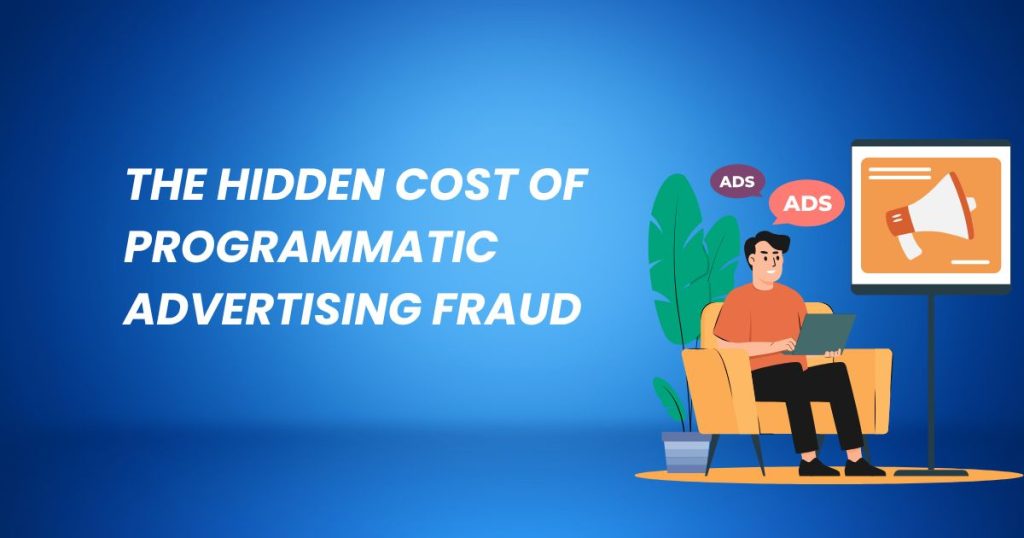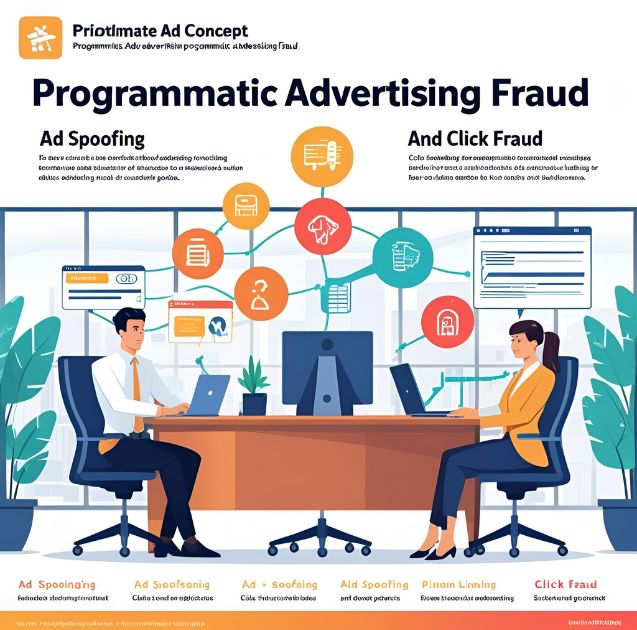The Hidden Cost of Programmatic Advertising Fraud

Digital advertising promised precision and efficiency. Instead, it delivered a multi-billion dollar fraud problem that’s bleeding marketing budgets dry.
Programmatic advertising revolutionized how brands reach consumers, automating ad buying and selling in real-time auctions. But this same automation created vulnerabilities that fraudsters exploit daily. Every click, impression, and conversion you pay for might not represent a real person—it could be a bot, a fake website, or a sophisticated scam designed to steal your advertising spend.
Understanding programmatic advertising fraud isn’t just about protecting your budget. It’s about ensuring your marketing efforts actually reach human audiences and drive genuine business results. This post examines the most common types of fraud plaguing programmatic advertising, their impact on businesses, and practical strategies to defend against them.
What is Programmatic Advertising Fraud?

Programmatic advertising fraud occurs when bad actors manipulate automated ad buying systems to generate illegitimate revenue. Unlike traditional advertising fraud, which required manual intervention, programmatic fraud exploits the speed and complexity of real-time bidding systems.
The scale is staggering. Industry estimates suggest ad fraud costs businesses between $35-50 billion annually, with programmatic advertising bearing the brunt of these losses. This fraud doesn’t just waste money—it skews performance data, making it impossible to optimize campaigns effectively.
Fraudsters target programmatic advertising because of its automated nature. Real-time bidding happens in milliseconds, leaving little time for human oversight. This creates opportunities for sophisticated fraud schemes that can operate at a massive scale before detection.
Common Types of Programmatic Advertising Fraud
Bot Traffic Fraud
Bot traffic represents the most widespread form of programmatic advertising fraud. Sophisticated bots mimic human behavior, visiting websites, clicking ads, and even completing forms. These bots consume advertising inventory without providing any real value to advertisers.
Modern bots have evolved beyond simple automated scripts. They can simulate mouse movements, scroll through content, and even interact with JavaScript elements. Some bots use residential IP addresses and rotate user agents to appear more human-like.
The challenge with bot traffic lies in detection. Advanced bots can fool basic verification systems, making them appear as legitimate users in campaign reports. This creates a false sense of campaign success while draining advertising budgets.
Domain Spoofing
Domain spoofing involves fraudsters misrepresenting low-quality websites as premium publishers. They manipulate bid requests to make their inventory appear as if it comes from reputable news sites or popular entertainment platforms.
This fraud type is particularly damaging because advertisers pay premium prices for what they believe is high-quality inventory. Instead, their ads appear on questionable websites with little traffic or engagement.
Spoofing exploits gaps in the supply chain verification process. When multiple intermediaries handle bid requests, it becomes difficult to verify the true source of advertising inventory.
Pixel Stuffing
Pixel stuffing involves placing ads in tiny, invisible spaces on web pages. These ads are technically “viewable” according to basic measurement standards, but humans cannot actually see them. Fraudsters collect impression revenue without delivering any advertising value.
This technique exploits traditional viewability metrics that only measure whether an ad is technically visible, not whether it’s actually seen by users. Ads stuffed into 1×1 pixel spaces meet basic viewability requirements while providing zero brand exposure.
Ad Stacking
Ad stacking places multiple ads in the same position on a webpage, with only the top ad visible to users. All stacked ads register as viewable impressions, allowing fraudsters to collect multiple payments for a single ad placement.
This type is particularly insidious because it can affect legitimate websites. Publishers might unknowingly use ad networks that employ stacking techniques, making them unwitting participants in fraud schemes.
The Impact on Businesses
Financial Losses
The most obvious impact of programmatic advertising fraud is direct financial loss. Businesses pay for fake impressions, clicks, and conversions that provide no value. These losses compound over time, significantly reducing marketing ROI.
Small businesses face disproportionate impacts from ad fraud. They often lack the resources to implement sophisticated fraud detection systems, making them easy targets for fraudsters. A single fraudulent campaign can devastate a small business’s advertising budget.
Distorted Analytics
Fraud corrupts campaign data, making it impossible to make informed optimization decisions. When bot traffic inflates metrics, marketers might increase spending on ineffective placements or continue targeting fraudulent inventory.
This data corruption extends beyond individual campaigns. Fraud can skew audience insights, leading to poor targeting decisions in future campaigns. Businesses might develop incorrect assumptions about their customers based on fraudulent data.
Brand Safety Risks
Domain spoofing and other fraud techniques can place brand ads on inappropriate websites. This creates brand safety risks that can damage reputation and consumer trust. Companies might unknowingly advertise on sites promoting illegal activities or controversial content.
Detection and Prevention Strategies
Implement Comprehensive Fraud Detection
Effective fraud detection requires multiple layers of verification. Real-time monitoring systems can identify suspicious traffic patterns, unusual engagement rates, and other fraud indicators. These systems should analyze both pre-bid and post-bid data.
Machine learning algorithms excel at detecting fraud patterns that humans might miss. They can identify subtle behavioral differences between human users and sophisticated bots, improving detection accuracy over time.
Use Ads.txt and Sellers.json
Ads.txt and sellers.json are industry standards designed to increase supply chain transparency. Ads.txt allows publishers to declare which companies are authorized to sell their inventory, while sellers.json provides information about the entities participating in programmatic transactions.
Implementing these standards helps prevent domain spoofing and unauthorized inventory sales. However, adoption remains incomplete across the industry, limiting its effectiveness.
Work with Trusted Partners
Choosing reputable demand-side platforms (DSPs) and supply-side platforms (SSPs) significantly reduces fraud exposure. Established platforms invest heavily in fraud detection and prevention technologies.
Due diligence should include evaluating partners’ fraud prevention capabilities, transparency policies, and willingness to provide detailed reporting. Partners who avoid discussing fraud prevention might not prioritize protecting your advertising spend.
Monitor Key Performance Indicators
Unusual patterns in campaign metrics often indicate fraud. Extremely high click-through rates, perfect conversion rates, or traffic spikes from specific geographic regions can signal fraudulent activity.
Regular auditing of campaign performance helps identify fraud indicators early. Establishing baseline metrics for normal campaign performance makes it easier to spot anomalies that warrant investigation.
Building a Fraud-Resistant Strategy

Diversify Traffic Sources
Relying too heavily on programmatic advertising increases fraud exposure. Diversifying across multiple channels—including direct publisher relationships, social media advertising, and search marketing—reduces overall risk.
Direct relationships with publishers provide greater transparency and control over ad placements. While this approach requires more manual management, it significantly reduces fraud risk.
Implement Viewability Standards
Moving beyond basic viewability metrics helps combat pixel stuffing and ad stacking. Implementing stricter viewability standards—such as requiring ads to be visible for longer periods or in larger sizes—reduces fraud vulnerability.
Advanced viewability measurement can detect whether ads are actually seen by human users, not just technically viewable according to industry standards.
Regular Campaign Audits
Conducting regular audits of programmatic campaigns helps identify fraud patterns and optimize prevention strategies. These audits should examine traffic sources, engagement patterns, and conversion quality.
Third-party verification services can provide independent analysis of campaign performance and fraud exposure. These services offer specialized expertise and tools that many businesses lack internally.
Protecting Your Advertising Investment
Programmatic advertising fraud represents a significant threat to marketing effectiveness and business profitability. The automated nature of programmatic systems creates vulnerabilities that fraudsters exploit with increasing sophistication.
However, businesses aren’t powerless against fraud. Implementing comprehensive detection systems, working with trusted partners, and maintaining vigilant monitoring can significantly reduce fraud exposure. The key lies in treating fraud prevention as an ongoing process, not a one-time solution.
Success in programmatic advertising requires balancing efficiency with security. While automation provides valuable benefits, it must be paired with robust fraud prevention measures to protect advertising investments.
As the programmatic advertising ecosystem continues evolving, fraud prevention will become increasingly important. Businesses that invest in comprehensive fraud protection today will be better positioned to capitalize on programmatic advertising’s benefits while minimizing its risks.





